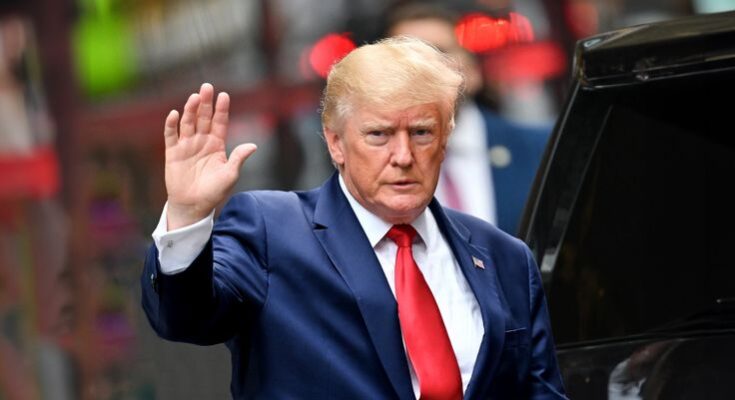In a move that sent shockwaves through North America and the global economy, former U.S. President Donald Trump imposed steep tariffs on steel and aluminum imports from Canada and Mexico in 2018. The decision, justified under the guise of national security, marked a dramatic escalation in trade tensions between the United States and its closest neighbors. The tariffs—25% on steel and 10% on aluminum—were met with outrage from Canadian Prime Minister Justin Trudeau and Mexican officials, who condemned the measures as unjustified and harmful to the longstanding trade relationships between the three nations. The move not only sparked panic among businesses and industries reliant on cross-border trade but also threatened to derail the renegotiation of the North American Free Trade Agreement (NAFTA), which had been a cornerstone of North American economic integration for decades.
### The Rationale Behind the Tariffs
Trump’s decision to impose tariffs on Canada and Mexico was rooted in his broader “America First” trade policy, which sought to protect U.S. industries and workers from what he described as unfair competition. The tariffs were implemented under Section 232 of the Trade Expansion Act of 1962, which allows the president to impose trade restrictions on national security grounds. Trump argued that the decline of the U.S. steel and aluminum industries posed a threat to national security, as these materials are critical for defense and infrastructure.
However, the decision to target Canada and Mexico—two of the United States’ closest allies and largest trading partners—was widely criticized as misguided and politically motivated. Canada and Mexico are integral to the North American supply chain, and the tariffs disrupted the delicate balance of trade that had been established under NAFTA. Critics argued that the tariffs were less about national security and more about leveraging economic pressure to force concessions in the ongoing NAFTA renegotiations.
### Justin Trudeau’s Response: Outrage and Retaliation
Canadian Prime Minister Justin Trudeau was quick to condemn the tariffs, calling them “absurd” and “unacceptable.” In a strongly worded statement, Trudeau emphasized the deep economic and cultural ties between Canada and the United States, noting that Canada is not only the largest supplier of steel and aluminum to the U.S. but also a key ally in defense and security matters. “The idea that Canada could pose a national security threat to the United States is frankly insulting and inconceivable,” Trudeau said.
Trudeau’s government responded to the tariffs with a carefully calibrated retaliation plan. Canada announced tariffs on $12.8 billion worth of U.S. goods, targeting products such as steel, aluminum, whiskey, orange juice, and agricultural goods. The retaliatory measures were designed to exert maximum political pressure, focusing on products from states that were key to Trump’s political base. For example, the tariffs on bourbon and whiskey were seen as a direct hit to Kentucky, the home state of then-Senate Majority Leader Mitch McConnell.
Trudeau also sought to rally international support, framing the U.S. tariffs as a threat to the global trading system. Canada filed a complaint with the World Trade Organization (WTO) and worked closely with other countries affected by U.S. trade actions, including the European Union and Mexico. Trudeau’s diplomatic efforts were aimed at isolating the United States and building a coalition of nations opposed to Trump’s protectionist policies.
### Economic Impact: Panic and Uncertainty
The tariffs on Canada and Mexico created immediate economic uncertainty, disrupting supply chains and raising costs for businesses on both sides of the border. The U.S. manufacturing sector, which relies heavily on Canadian and Mexican steel and aluminum, faced higher input costs, leading to price increases for consumers and potential job losses. Similarly, Canadian and Mexican industries that depend on exports to the U.S. were hit hard by the tariffs, with some companies forced to lay off workers or scale back production.
The tariffs also had a chilling effect on investment and business confidence. Companies that had long relied on the predictability of North American trade were suddenly faced with the prospect of prolonged trade tensions and escalating costs. The uncertainty surrounding NAFTA renegotiations further exacerbated the situation, as businesses struggled to plan for the future in an environment of heightened trade risk.
### NAFTA Renegotiations: A High-Stakes Standoff
The tariffs on Canada and Mexico came at a critical moment in the renegotiation of NAFTA, which had been a key priority for the Trump administration. Trump had long criticized NAFTA as a “disaster” for the U.S. economy, blaming the agreement for the loss of manufacturing jobs and the growth of the trade deficit with Mexico. His administration sought to renegotiate the deal to secure better terms for American workers and industries.
However, the imposition of tariffs on Canada and Mexico complicated the negotiations, creating a climate of mistrust and hostility. Canadian and Mexican officials made it clear that the tariffs would need to be lifted before they would agree to a new trade deal. The standoff threatened to derail the negotiations entirely, raising the prospect of a collapse of NAFTA and a return to pre-1994 trade barriers.
### Resolution and the USMCA
After months of tense negotiations, the Trump administration eventually agreed to lift the steel and aluminum tariffs on Canada and Mexico in May 2019. The decision was seen as a major breakthrough, paving the way for the three countries to finalize the United States-Mexico-Canada Agreement (USMCA), the successor to NAFTA. The USMCA included several updates to the original agreement, including provisions on digital trade, labor standards, and automotive manufacturing.
While the lifting of the tariffs was welcomed by businesses and policymakers, the episode left a lasting impact on the North American trade relationship. The tariffs had exposed the fragility of the U.S.-Canada-Mexico partnership and raised questions about the future of economic cooperation in the region. For Canada, the experience reinforced the need to diversify its trade relationships and reduce its dependence on the U.S. market.
### The Broader Implications of Trump’s Trade Policy
The tariffs on Canada and Mexico were emblematic of Trump’s broader approach to trade policy, which prioritized unilateral action and economic nationalism over multilateral cooperation. While the tariffs were intended to protect U.S. industries, they also created significant economic costs and strained relations with key allies. The episode highlighted the challenges of using trade policy as a tool for economic and geopolitical leverage, particularly in a highly interconnected global economy.
For Justin Trudeau, the tariffs were a test of his leadership and diplomatic skills. His response—combining firm retaliation with efforts to build international coalitions—demonstrated Canada’s commitment to defending its economic interests and upholding the rules-based international trading system. However, the experience also underscored the vulnerability of smaller economies to the actions of larger trading partners.
### Conclusion
Donald Trump’s decision to impose steep tariffs on Canada and Mexico in 2018 was a defining moment in North American trade relations. The move sparked panic and tension, disrupting supply chains, raising costs for businesses, and threatening the future of NAFTA. Justin Trudeau’s strong response, including retaliatory tariffs and diplomatic efforts, highlighted Canada’s determination to defend its economic interests and uphold the principles of free trade.
While the eventual lifting of the tariffs and the signing of the USMCA helped to ease tensions, the episode left a lasting impact on the North American trade relationship. It served as a stark reminder of the challenges and risks associated with protectionist trade policies, particularly in a region as economically integrated as North America. As the U.S., Canada, and Mexico move forward under the USMCA, the lessons of the tariff dispute will continue to shape the future of trade policy in the region.



